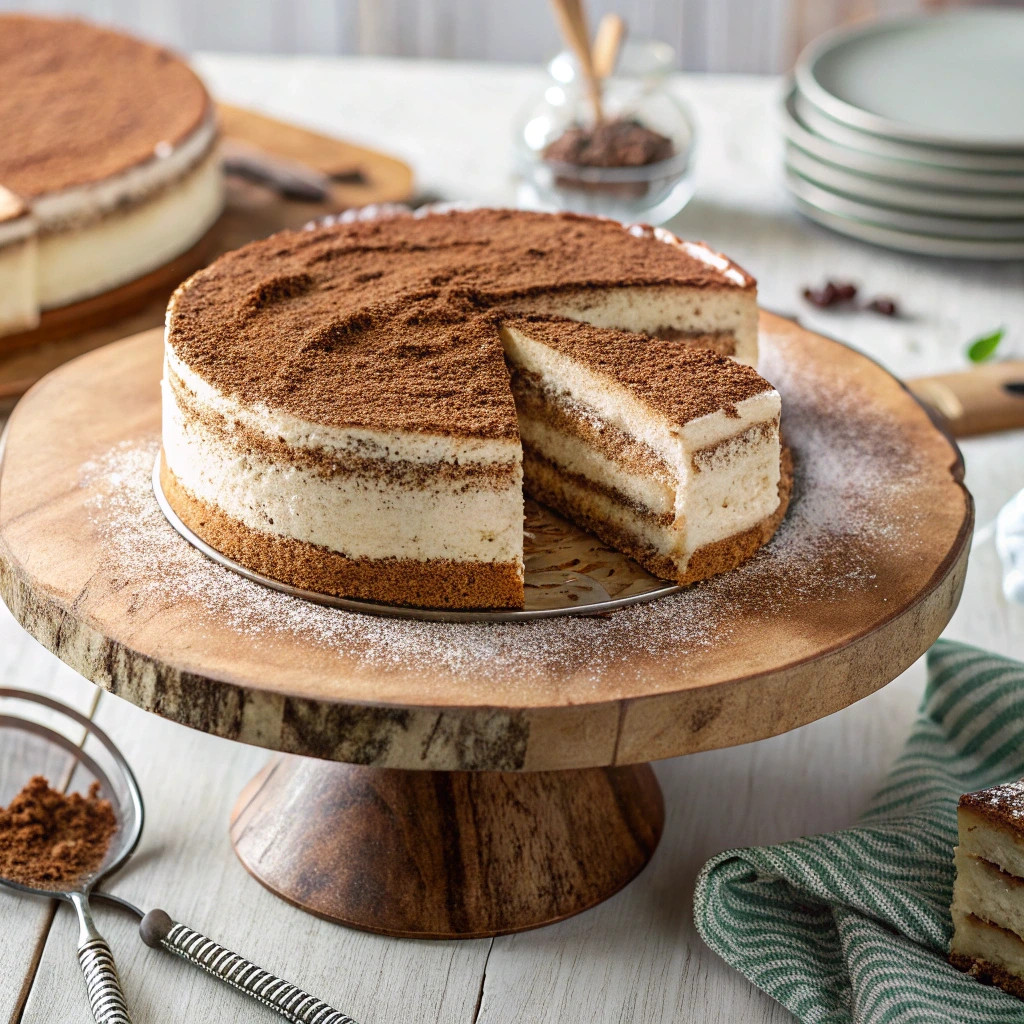I’m Mary from Bath—most folks call me The Pudding Lady. My love for baking began in my mum’s pantry, where flour dusted everything, and the golden syrup stuck to every lid. I never trained as a pastry chef—too impatient, too ambitious—but I baked. Oh, did I bake. Victoria sponges, glossy treacle puds, the lot.
Now, I run a cozy little weekend pudding club from my kitchen, teaching old-school favorites with a dash of magic.
That’s why I fell hard for tiramisu sponge cake. It’s not just a dessert—it’s a perfect marriage of light sponge layers, coffee-soaked elegance, and mascarpone cream so smooth it almost sings. It’s part Italian romance, part British comfort, and entirely irresistible.
In this article, we’ll explore every rich, velvety, cocoa-dusted layer—from where tiramisu sponge cake came from, to how to make it sing in your own kitchen. Whether you’re a curious beginner or a devoted dessert-maker, this one’s for you.

Table of Contents
Table of Contents
What Is Tiramisu Sponge Cake?
Origin and History of Tiramisu
Tiramisu traces its roots back to Treviso, Italy, in the 1960s, believed to be created by combining ladyfingers (savoiardi), espresso, mascarpone cheese, eggs, and cocoa powder. While the original is served chilled in a dish, the tiramisu sponge cake format elevates this dessert to new levels—by turning it into a layer cake using sponge as the base instead of biscuits.
The traditional dessert became globally beloved because it combines contrasting textures and complementary flavors: the bitterness of coffee, the richness of mascarpone, and the sweetness of the sponge or ladyfingers.
As global palates evolved, pastry chefs began replacing the finger-shaped biscuits with soft sponge cake for better structure, more controlled layering, and a gourmet aesthetic.
What Makes Tiramisu Sponge Cake Unique Compared to Regular Tiramisu?
Unlike the no-bake, dish-served tiramisu, a tiramisu sponge cake is baked and constructed like a layer cake—yet retains all the flavor essentials: espresso-soaked layers, creamy mascarpone filling, and a dusting of unsweetened cocoa powder.
Print
Tiramisu Sponge Cake
- Total Time: 2 hours 55 minutes
- Yield: 8 servings 1x
- Diet: Vegetarian
Description
A light and airy tiramisu-inspired sponge cake layered with coffee syrup and mascarpone cream.
Ingredients
- 6 large eggs
- 150g granulated sugar
- 150g all-purpose flour
- 1 tsp vanilla extract
- 1 pinch of salt
- 250g mascarpone cheese
- 200ml heavy cream
- 50g powdered sugar
- 200ml strong brewed coffee, cooled
- 2 tbsp coffee liqueur (optional)
- Unsweetened cocoa powder for dusting
Instructions
- Preheat oven to 180°C (350°F) and line two 20cm cake pans with parchment paper.
- Separate the eggs. Beat egg whites with salt until soft peaks form. Gradually add half the sugar and beat until stiff peaks form.
- In another bowl, beat yolks with remaining sugar and vanilla until pale and thick.
- Fold the yolk mixture into the whites gently, then sift in the flour and fold to combine.
- Divide batter between the pans and bake 20–25 minutes. Let cool completely.
- Whip the cream with powdered sugar to soft peaks, then gently fold in the mascarpone until smooth.
- Mix the coffee with liqueur if using. Brush generously over each cake layer.
- Spread half the mascarpone cream on one cake layer. Place the second cake layer on top and spread remaining cream.
- Dust with cocoa powder and chill at least 2 hours before serving.
Notes
For stronger coffee flavor, increase the amount of coffee liqueur. Ensure cakes are fully cooled before assembling.
- Prep Time: 30 minutes
- Cook Time: 25 minutes
- Category: Dessert
- Method: Baking
- Cuisine: Italian
Nutrition
- Serving Size: 1 slice
- Calories: 380
- Sugar: 18g
- Sodium: 120mg
- Fat: 24g
- Saturated Fat: 14g
- Unsaturated Fat: 9g
- Trans Fat: 0g
- Carbohydrates: 34g
- Fiber: 1g
- Protein: 6g
- Cholesterol: 140mg
Here’s why it’s so unique:
- Structural Integrity: The sponge holds up better than ladyfingers when soaked, allowing for cleaner slices.
- Presentation: It looks more like a classic birthday or wedding cake, ideal for events and gifting.
- Flavor Distribution: Each bite delivers consistent layers of cream and coffee, offering balanced indulgence.
- Customization-Friendly: You can add a hint of liqueur, infuse different flavorings, or even make it into cupcakes.
This cake has made its way into upscale bakeries and modern kitchens because of its versatility and sheer elegance.
Check out Tiramisu Cookies if you’re craving a more handheld version of this flavor-packed dessert.
Key Ingredients of a Perfect Tiramisu Sponge Cake

Essential Ingredients for the Sponge Layer
The sponge serves as the foundation of any tiramisu sponge cake, providing structure and absorbing all the rich flavors. Unlike ladyfingers that can get soggy, sponge cake offers structure while still absorbing flavor.
Here’s what you’ll need for a traditional sponge:
- Eggs (room temperature) – provide volume and richness
- Granulated sugar – for sweetness and texture
- Cake flour – lighter than all-purpose, ensures a soft, airy texture
- Vanilla extract – adds aromatic depth
- Salt – enhances all other flavors
Whisking the eggs and sugar until thick and pale is critical to achieve the sponge’s trademark airy quality. The goal is to bake a flexible, moist base that soaks up espresso beautifully without turning mushy.
Cream Layer Components: Mascarpone, Eggs, and Sugar
The cream layer is what sets tiramisu apart from other cakes. It’s decadent, smooth, and dreamy.
Main ingredients include:
- Mascarpone cheese – creamy and mildly sweet, this is non-negotiable for authenticity
- Egg yolks – traditionally used raw, or cooked into a sabayon for safety
- Granulated sugar – balances the tanginess of mascarpone
- Whipped cream (optional) – lightens the texture
- Vanilla bean or extract – for added aroma
This silky filling spreads beautifully between the cake layers and complements the coffee-infused sponge without being overly sweet.
Coffee and Cocoa: The Flavor Backbone
The robust espresso flavor and classic cocoa dusting are what define the signature taste of tiramisu sponge cake. Here’s how to master them:
- Strong brewed espresso or coffee – freshly made, cooled, and unsweetened
- Coffee liqueur (like Kahlúa) – optional, but adds warmth and complexity
- Unsweetened cocoa powder – lightly sprinkled on top to enhance contrast and add a touch of visual elegance.
Make sure the coffee is absorbed evenly—too much and the cake turns soggy, too little and it won’t have that iconic tiramisu punch.
Optional Add-ins for Personalization (Liquors, Nuts, etc.)
Want to get creative with your tiramisu sponge cake? Here are some popular twists:
- Alcoholic Variants: Try Marsala wine, Amaretto, or Baileys for deeper flavor.
- Chocolate Shavings: Sprinkle between layers for extra texture.
- Toasted nuts: Add crushed hazelnuts or almonds for crunch.
- Fruit Infusions: Strawberries or raspberries for a fresh contrast.
These small tweaks can elevate your dessert to a gourmet experience that suits any occasion or audience.
Discover great ideas like Smores Brownies for more dessert layering inspiration.
Choosing the Right Sponge Cake for Tiramisu
Genoise vs. Ladyfingers: Which Is Better?
One of the key choices when making a tiramisu sponge cake is selecting the right cake base. The classic tiramisu uses ladyfingers (savoiardi)—firm, dry biscuits that soak up coffee like sponges. However, when adapting the dessert into a cake format, Genoise sponge is the top choice for pastry chefs.
Here’s how they compare:
| Feature | Ladyfingers | Genoise Sponge Cake |
|---|---|---|
| Texture | Firm, biscuit-like | Soft, elastic, airy |
| Absorption Rate | Very high (can get soggy) | Balanced, controlled soak |
| Flavor Distribution | Uneven, depends on layering | Even across layers |
| Presentation | Rustic | Clean, elegant cake finish |
| Baking Required | Pre-made or homemade | Must be baked fresh |
Genoise sponge cake is made by whipping whole eggs and sugar over heat until thick, then gently folding in flour. The result? A light and tender base that holds its form while absorbing just enough espresso.
Looking for inspiration? Try Mini Chocolate Cakes for more elegant, layered dessert formats.
How Texture Affects Absorption and Flavor Balance
Texture plays a major role in how your tiramisu sponge cake tastes. If the sponge is too dry or too dense, it won’t absorb the espresso evenly, leaving you with bland bites. On the flip side, overly airy sponge can collapse when soaked, turning the cake into a mushy mess.
Here’s what to aim for:
- Even crumb structure: A fine crumb helps trap flavor in every layer.
- Moist but firm texture: Just dense enough to stay stable under cream and coffee layers.
- Flexible sponge sheets: Ideal for cutting and layering without crumbling.
To achieve this, ensure your eggs are well-whipped and ingredients are folded gently. Avoid overbaking to prevent dryness.
Learn more about Heavenly Chocolate Cheesecake Trifle for lessons on balancing rich layers in dessert design.
Step-by-Step Recipe for Homemade Tiramisu Sponge Cake

If you’re ready to roll up your sleeves and bake a decadent dessert, this tiramisu sponge cake recipe walks you through each layer with clarity and precision. From the espresso-soaked sponge to the cloud-like mascarpone filling, here’s how to bring this Italian classic to life in cake form.
Preparing the Coffee-Soaked Sponge Cake
First up, the sponge base. We’ll use a classic Genoise sponge for its balance of structure and tenderness.
Ingredients (for sponge):
- 5 large eggs
- 3/4 cup granulated sugar
- 1 tsp vanilla extract
- 1 cup cake flour (sifted)
- 1/4 tsp salt
- 2 tbsp unsalted butter (melted and cooled)
Instructions:
- Preheat oven to 350°F (175°C). Line two 8-inch round cake pans with parchment paper.
- In a heatproof bowl over simmering water, whisk eggs and sugar until warm to the touch and sugar dissolves.
- Transfer to a stand mixer. Beat on high until tripled in volume (about 7–10 minutes).
- Add vanilla, then gently fold in sifted flour and salt in batches.
- Fold in melted butter last. Do not overmix.
- Pour into pans and bake for 20–25 minutes. Cool completely.
Once cool, use a fork or skewer to gently poke holes across the surface—this helps the espresso soak in evenly.
Espresso Soak:
- 1 cup strong brewed espresso (cooled)
- 2 tbsp coffee liqueur (optional)
Brush or spoon espresso generously over both sponge layers until saturated but not soggy.
Making the Silky Mascarpone Cream Filling
The mascarpone cream is where tiramisu’s indulgence really shines.
Ingredients (for filling):
- 1 cup mascarpone cheese
- 3 large egg yolks
- 1/2 cup granulated sugar
- 1 cup heavy whipping cream
- 1 tsp vanilla extract
Instructions:
- In a double boiler, whisk egg yolks and sugar until thickened and pale (about 7 minutes). Let cool.
- In a bowl, beat mascarpone until smooth.
- Whip the cream separately until stiff peaks form.
- Fold cooled egg mixture into mascarpone, then fold in whipped cream.
- Chill for 30 minutes before assembling.
Layering and Assembling the Tiramisu Sponge Cake
Here’s how to put it all together for maximum flavor and visual appeal:
- Place the first sponge layer on a serving plate.
- Spread half the mascarpone cream evenly across the layer.
- Top with the second sponge layer (espresso-soaked side facing down).
- Spread the remaining cream on top and smooth out with a spatula.
- Cover and refrigerate for at least 6 hours, preferably overnight.
Final Touches: Cocoa Dusting and Chilling Time
Before serving:
- Dust generously with unsweetened cocoa powder.
- For presentation, use a stencil to create cocoa patterns or add chocolate curls.
Don’t miss our Romantic Chocolate and Strawberry Cupcakes for creative decorating ideas that can be adapted to tiramisu cake.
Pro Tip: Always chill the cake for several hours to allow the layers to firm up and flavors to meld. Cutting into a freshly assembled tiramisu sponge cake can result in a runny mess.
Pro Tips to Make Your Tiramisu Sponge Cake Stand Out
Creating a tiramisu sponge cake that’s not only delicious but also visually stunning comes down to the details. While the ingredients and layering are essential, mastering the technique and presentation will take your dessert from homemade to patisserie-quality.
How to Prevent a Soggy Bottom Layer
One of the most common tiramisu mistakes? A sponge cake that’s too wet and starts collapsing.
To avoid that:
- Manage the espresso soak by using a pastry brush to gently apply the coffee, ensuring even coverage without oversaturating the cake. This allows you to soak gradually and evenly.
- Let the sponge cool fully before soaking—it absorbs better and avoids steaming the cream layer.
- Avoid over-soaking near the edges, which tend to be more fragile and prone to leaking cream.
Also, remember that the coffee temperature matters. Always cool your espresso before applying it to the sponge. Hot coffee can compromise the structure of your cake.
Best Practices for Chilling and Setting
A good tiramisu sponge cake needs time to set. This helps the layers fuse and the flavors mature.
Follow these rules:
- Chill the cake for at least 6–8 hours, or overnight if possible.
- For clean, well-defined layers, use a cake ring or a springform pan during assembly.
- For neat, smooth slices, use a warm knife—dip it in hot water and wipe it clean between each cut
Cover the cake tightly with plastic wrap to avoid absorbing fridge odors. You can also place it in a cake dome if you plan to display it later.
Serving Tips for Clean Slices
We all want that clean, Instagram-worthy cake slice—and it’s possible with tiramisu sponge cake, too!
Here’s how:
- Use a serrated knife for a gentle sawing motion.
- Wipe your blade after each slice—this keeps the cream from smearing.
- Serve slightly chilled for stability, but not ice-cold. 10–15 minutes out of the fridge is ideal.
Bonus tip: garnish with chocolate curls, coffee beans, or a light dusting of powdered sugar for an elegant finish.
Variations and Twists on the Classic Tiramisu Sponge Cake

Tiramisu sponge cake may be rooted in Italian tradition, but its flexible format makes it a dream for customization. Whether you’re baking for kids, avoiding certain ingredients, or just feeling adventurous, there are countless ways to adapt the core recipe without compromising on flavor.
Tiramisu Cupcakes, Tarts, and Mini Cakes
Turn this classic into fun-sized, portable treats that pack all the same layered goodness:
- Tiramisu Cupcakes: Use coffee-soaked cupcake bases and pipe mascarpone cream on top. Finish with a dusting of cocoa powder and a chocolate-covered espresso bean for a classic, elegant touch.
- Mini Tiramisu Cakes: Bake sponge in ramekins or cut into circles with a cookie cutter. Assemble just like the full-sized version but in smaller stacks—great for parties!
- Tiramisu Tart: Swap the sponge base for a cocoa tart shell, fill with mascarpone cream, and top with espresso jelly or dusted cocoa.
These mini versions are perfect for special occasions or dessert tables and offer better portion control without losing the tiramisu experience.
Alcohol-Free and Kid-Friendly Versions
Tiramisu often features coffee liqueurs like Kahlúa or Marsala, but you can skip the alcohol and still preserve the rich flavor by using strong brewed espresso or coffee concentrates:
- Swap out the alcohol for vanilla extract, orange juice, or sweetened espresso to maintain flavor without the booze.
- Try using hot chocolate in place of coffee for a completely caffeine-free twist on classic tiramisu.
- Add layers of fruit like banana or strawberries to brighten up the cake for younger palates.
This way, even kids and guests avoiding alcohol can enjoy the tiramisu sponge cake safely.
Vegan and Gluten-Free Alternatives
Dietary restrictions? No problem. Here’s how to tweak your tiramisu sponge cake to suit different needs:
For a Vegan Tiramisu Sponge Cake:
- Replace eggs in the sponge with aquafaba (chickpea brine) or flaxseed meal.
- Use vegan mascarpone (available in specialty stores or homemade from soaked cashews and coconut cream).
- Substitute dairy cream with coconut or soy-based whipping cream.
- Use dairy-free milk and vegan chocolate shavings for garnish.
For a Gluten-Free Version:
- Use gluten-free cake flour or almond flour blend.
- Make sure all components (like cocoa and flavorings) are certified gluten-free.
With these substitutions, your tiramisu sponge cake can be enjoyed by nearly anyone—without losing that classic cream-and-coffee combo.
Storage, Shelf Life & Food Safety
Tiramisu sponge cake is indulgently rich and creamy, made with layers of ingredients that require careful refrigeration due to their perishability. That means proper storage isn’t just about preserving flavor—it’s also about food safety. Whether you’ve got leftovers or you’re preparing in advance, this guide helps you keep your cake fresh and delicious.
How Long Can Tiramisu Cake Sit Out Safely?
Because tiramisu sponge cake contains dairy (mascarpone and cream) and often eggs, it should not sit at room temperature for long.
- Maximum time unrefrigerated: 2 hours
- In warm environments (above 75°F), limit to 1 hour
After that, bacteria can begin to multiply, potentially leading to spoilage or foodborne illness. Always refrigerate promptly after serving if there are leftovers.
Fridge vs. Freezer: What Works Best?
Here’s how to keep your tiramisu sponge cake fresh, depending on how long you need to store it:
| Storage Method | Duration | Tips |
|---|---|---|
| Refrigerator | 3 to 4 days | Store in an airtight container or wrap tightly to prevent drying |
| Freezer | Up to 2 months | Wrap each slice in plastic, then foil; thaw in the fridge overnight |
Pro Tip: For best results, freeze the cake before dusting it with cocoa powder—add the topping after thawing to avoid a wet, clumpy appearance.
The mascarpone cream may separate slightly when frozen and thawed, but this can often be smoothed out by allowing the cake to fully come to temperature in the fridge before slicing.
Signs of Spoilage to Watch For
Tiramisu sponge cake is visually beautiful and fragrant—but when it starts to go bad, the signs are clear.
Watch for:
- Sour smell from the mascarpone or cream
- Discoloration (especially gray or green tones)
- Slimy or curdled cream layers
- Dry, cracked sponge or excessive hardness
If you notice any of the above, it’s safest to discard the cake. Don’t risk tasting if you suspect spoilage.
To maintain the perfect balance of flavor and texture, enjoy your tiramisu sponge cake within a few days—and always keep it chilled.
Final Thoughts – Why Tiramisu Sponge Cake Will Always Be a Dessert Classic
Tiramisu sponge cake is more than a sweet treat—it’s an experience. The moment you take a bite, you’re hit with a burst of strong coffee, velvety mascarpone, and cocoa’s earthy finish, all layered between soft sponge that’s soaked just enough to melt on your tongue.
The Sensory Magic of Coffee, Cream, and Sponge
What makes this cake a standout isn’t just the recipe—it’s the contrast in texture and harmony in flavor. You get:
- Soft yet firm sponge layers
- Creamy mascarpone that feels light but indulgent
- Espresso that adds depth without overwhelming
- Cocoa powder that ties it all together with subtle bitterness
This makes tiramisu sponge cake one of the few desserts that truly satisfies both coffee lovers and sweet-toothed eaters alike.
Perfect Occasions for Serving Tiramisu Sponge Cake
This cake is ideal for:
- Dinner parties – it serves clean slices and can be made ahead
- Perfect for holiday gatherings—elegant and impressive without the need for intricate frosting techniques.
- Birthdays – especially for adults who prefer layered cream over buttercream
- Ideal for weddings or engagement celebrations—a refined and stylish alternative to classic tiered cakes
It’s a dessert that’s versatile, classy, and always welcome at the table.
Where to Buy or Order Gourmet Versions Online
If you’re short on time or curious about professionally crafted versions, consider exploring bakeries that offer Italian-style desserts or modern fusion cakes.
Don’t miss our Tiramisu Cake for inspiration, or to compare your homemade version with a professionally photographed gourmet creation.
You can also find artisanal tiramisu sponge cakes on platforms like Goldbelly, local patisseries, or specialty dessert cafés that deliver nationally.
Fore more recipes follow me in Facebook, medium and Pinterest
FAQs
What is so special about tiramisu cake?
Tiramisu cake is special because it combines the bold flavor of espresso-soaked sponge with the light, creamy texture of mascarpone and whipped cream. It’s a dessert that appeals to nearly every palate: rich without being too heavy, sweet but balanced by the bitterness of coffee and cocoa. When made in sponge cake form, it also becomes easier to slice and serve at celebrations, giving it both visual appeal and structural integrity. The tiramisu sponge cake version adds the bonus of layers that hold their shape, enhancing the dessert experience.
How long can tiramisu cake sit out?
Due to its dairy-based filling and delicate ingredients, tiramisu sponge cake should not sit out for more than 2 hours at room temperature. In warmer climates or during summer months, even 1 hour may be the safe limit. After that, you risk spoilage. Always refrigerate it promptly after serving, and avoid leaving it uncovered or near heat sources.
What kind of sponge is used in tiramisu?
In traditional tiramisu, ladyfingers (savoiardi) are used. However, for tiramisu sponge cake, most bakers use Genoise sponge—a light, egg-based cake that absorbs espresso well without falling apart. It offers a soft yet structured bite that holds creamy fillings and coffee flavors perfectly, making it the ideal choice for layered tiramisu cakes.
What kind of cake is tiramisu?
Tiramisu is classified as a layered, chilled dessert traditionally made with ladyfingers, mascarpone, espresso, and cocoa. When transformed into tiramisu sponge cake, it becomes a baked layer cake with the same core flavors, but a more stable structure. It’s considered a no-frosting, cream-layered cake—perfect for those who enjoy texture and taste without overly sweet icing.




